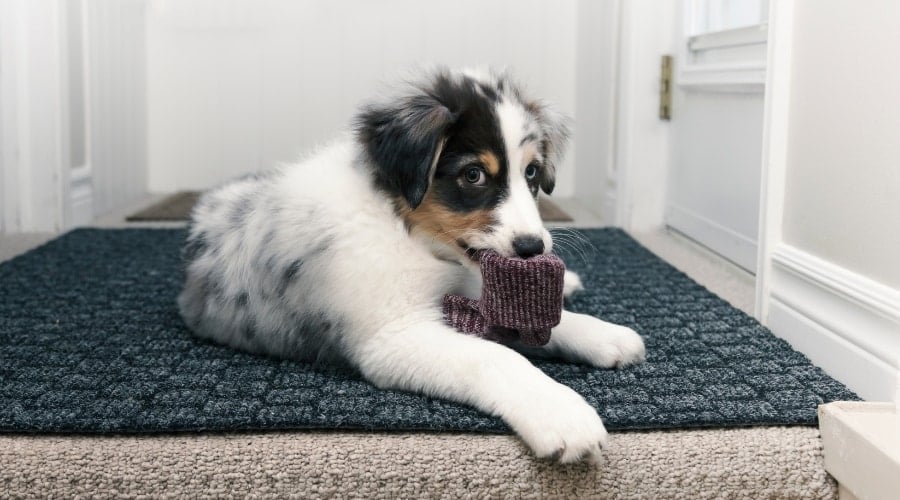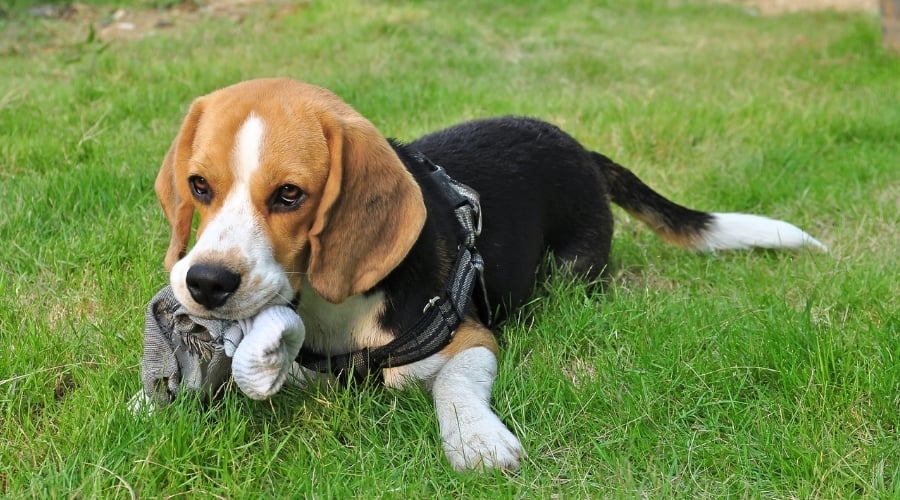Most dogs know the difference between eating objects and food. But we all know those naughty pooches who are prone to eating things they shouldn’t. If this resonates with you and you are reading this thinking, “yes, I have a dog like that, and he literally just ate a sock,” then this article is for you.
There are all sorts of things that dogs have been known to eat. Common culprits include tennis balls, toys, dishcloths, and various pieces of clothing. One of the most common items that pet dogs swallow is socks.
If this happens, there is the possibility that it may lead to a blockage in your dog’s intestines. This is why it’s important to know what to do if your canine companion does happen to swallow a sock. You’ll want to act quickly to prevent a blockage, and time is of the essence. Let’s look at what you can expect and your next steps.
My Dog Ate A Sock. What Now?

First of all, do not panic. You’ll need to keep a clear head to help your pup. Make sure Fido is somewhere safe where he cannot eat any more socks or other inedible objects.
Call your veterinarian right away for advice. Make sure you tell them when you think the sock was eaten. You’ll also need to know the approximate weight and breed of your pup. Your vet can use this information to decide on the best next steps. Do not attempt to make your pup regurgitate unless instructed to do so by your veterinarian.
What Happens If My Dog Eats A Sock?

Vomiting may occur soon after eating or drinking and may even be projectile. However, the absence of vomiting does not mean that a sock wasn’t ingested. Vomiting is usually a sign that the sock has become stuck somewhere in his digestive tract. If your canine companion is not vomiting, it may be that the foreign body is yet to become stuck. But it doesn’t mean it won’t cause a blockage at a later date.
Other signs that your pup has eaten a sock may include lethargy (having less energy than he usually would), drooling excessively, not eating (or eating less than normal), panting more than normal, diarrhea, constipation, or stools that look black. If it was ingested a while ago, you may notice weight loss. Be aware that your pup may continue to have bowel movements, even if a sock is stuck somewhere in his digestive tract.
It is important to know that your dog could show any of these signs even if he hasn’t eaten a sock. If you are unsure and notice any of these signs, make sure you get him checked by your veterinarian.
What Will My Veterinarian Do?
Once you’ve identified that you have a problem and take Fido to the veterinarian, there is a sequence of steps your veterinarian will take depending on your pup’s condition. Next, we look at each step in greater detail to help you understand what to expect.
Diagnosis

Your veterinarian will begin by completing a top-to-tail examination. Performing certain steps will help your veterinarian identify if any pain is present and what steps need to be taken right away. Usually, this examination will include the following:
Heart & Breathing Examination
One or both of these may be increased if your dog is sick or uncomfortable. Your vet can tell a lot about your dog’s health by doing a basic examination to check for their core vital signs.
Checking For Dehydration
Dehydration can occur if your pup isn’t eating or drinking or if he’s vomiting or has diarrhea. Dehydration can lead to other problems if untreated and can signify that your pup needs urgent attention.
Feeling Their Stomach
Your dog may show signs of discomfort during this part of the exam. Especially if the sock has obstructed his intestines. Sometimes, your veterinarian can feel the sock stuck in your dog’s intestines. Although, this is often not possible.
Treatment & Induced Vomiting

Depending on how recently the sock was swallowed, your veterinarian may administer some medicine (an ‘emetic’) to induce vomiting. They do this hoping he will bring the sock back up. This is usually given by injection and will only be done if they suspect it’s still in their stomach (as opposed to it having traveled further down his digestive tract into his intestines).
The effects of the injection tend to wear off after about 15-20 minutes. Your pup may feel nauseous for a few hours afterward. If your pup continues to vomit, your veterinarian may give him another injection to stop the sickness (an anti-emetic).
On occasion, the injection to encourage regurgitation may not work. Or, your dog might vomit stomach contents without vomiting up the sock. If this happens, you may wonder, ‘will it pass?’. It might be that your veterinarian recommends waiting to see if it will pass on its own. This will be dependent on Fido’s size and the size of the sock that was eaten.
If it is unlikely the sock will pass through the digestive tract without it becoming stuck and causing an obstruction, then surgery will be recommended. Pet insurance may help cover the expenses of emergency care and surgery, however, only if your pup is already on an active policy.
Further Testing

If it was some time ago that the sock was ingested, then your veterinarian may suggest further tests to try and establish where in the digestive system the sock is. It’s important to establish whether or not it is causing a bowel obstruction.
The most useful tests to try and establish this are either x-rays or an ultrasound of your dog’s abdomen. Occasionally, an endoscope (a small camera that is passed down the throat) or a CT scan may be required.
Your veterinarian may also suggest a blood test to check if there has been any effect on your dog’s other organ functions. This will also help identify if there are any disturbances to his salt balance that need correcting. Your vet may start a drip to achieve this or provide him with vital fluid if he is showing signs of dehydration.
Surgery For A Bowel Obstruction

The type of surgery required will depend on where in his digestive system the sock is. It will also depend on how long it’s been there. For all types of surgery, dogs will require a full general anesthetic, and an incision will be made into their abdomen. If the sock has only recently become stuck and there is no damage to the intestines, then a cut will be made in the intestine to retrieve the sock carefully.
If the sock has been stuck for a while, then that part of the intestines may be irreversibly damaged as a result of the blood supply being cut off by the obstruction. In rare cases, the part of the intestines where the sock is stuck may break down and rupture. This causes a severe, life-threatening infection called peritonitis. In either of these circumstances, the damaged part of your dog’s intestine must be surgically removed.
Will My Dog Be Okay?

If a sock was eaten recently and has been vomited sock back up, your pup will probably make a full and almost immediate recovery. At the very most, he may have a tummy upset for a couple of days.
If surgery is required, then this does carry an element of risk. In uncomplicated surgeries where there is no need to remove any part of the intestines, the prognosis for a full recovery is usually very good.
If your dog requires the removal of part of his bowel, then there is a higher risk of postoperative complications. Your pup will be carefully monitored for these in the hospital after his surgery. Once your dog has recovered from surgery, it is unlikely that he will suffer any long-term side effects from losing part of his bowel.
The exception to this is if a large part of the intestine has been damaged and needs to be removed. If this is the case, then your canine companion may be more prone to diarrhea and other digestive issues in the future.
In the event of an obstruction leading to a rupture of the bowel, your dog has a much more guarded prognosis and a higher risk of death, although a full recovery is still possible.
What If I am Not Sure My Dog Swalled A Sock?
If you are not sure your dog swallowed a sock (or any other foreign object) but suspect he did, it’s always best to call your vet. Most likely, the doctor will want to take a look at your dog’s stomach and perform an exam. The risk of a bowel obstruction is too great to risk it. Some dogs may vomit or even pass a sock, but it is always better to play it safe. Watch your dog for signs like excessive drooling, pain, and vomiting. A dog excessively vomiting needs medical attention right away.
Frequently Asked Questions
Can a dog survive eating a sock?
A dog can survive eating a sock, but the hours right after it happens are vital. Owners must observe their pups closely and contact the vet right away. Quick treatment is key. If the sock has not passed or been vomited out in 24 hours, your pet may need surgery to remove the sock.
Should I induce vomiting at home?
It is always safer for your veterinarian to induce vomiting than for you to try and do this yourself at home. Your veterinarian will check your dog over to make sure it is safe to make him sick and will monitor him closely whilst he vomits to check he does not choke or accidentally inhale any vomit. You may find hydrogen peroxide recommended to induce vomiting on the internet- it is only recommended to give this under the instruction of your veterinarian.
How long does it take a dog to poop out a sock?
If your dog has swallowed a sock, there is a good chance it will become stuck somewhere in his digestive tract, so always contact your veterinarian for advice. If the sock is going to pass, it can sometimes take several days, although this will usually happen within 24-36 hours.
How do you know if there’s a blockage?
Several signs may indicate that a blockage is present. He may vomit after eating and drinking, eat less or stop eating altogether, become more lethargic, or even lose weight. Bear in mind that it is still possible for bowel movements to occur even with a blockage.
Will a dog still eat if they have an obstruction?
A dog may still eat if they have an obstruction, especially if it has happened recently. They will frequently vomit back what they do eat, however. If an obstruction has been present for a while, they are more likely to go off their food and eat much less or stop eating altogether.
Can a bowel obstruction clear on its own?
If the bowel is fully obstructed, it will not be clear. Sometimes a partial bowel obstruction may clear on its own. Still, it is always important to contact your veterinarian for advice, as any kind of bowel obstruction can result in death if left untreated.
How much does surgery cost to remove a sock from a dog’s stomach?
This will vary hugely depending on the type of surgery that takes place, how long they need to stay in the hospital, and what type of medications they need, as well as other factors. The cost to treat an intestinal obstruction could range anywhere from $700-$7,000. Your veterinarian will be able to give you a more accurate estimate.
Final Thoughts
Remember that dogs who tend to eat foreign objects are usually repeat offenders. For dogs that require multiple surgeries, the level of risk increases with each subsequent surgery. So, every effort should be made to prevent access to objects they try to may ingest.
If you think your dog may have eaten a sock, the most important thing to do is contact your veterinarian immediately for advice. If the sock becomes stuck in his digestive tract and the problem is left untreated, your dog can quickly become very sick and could die. However, with prompt veterinary treatment, most dogs will usually recover quickly.





